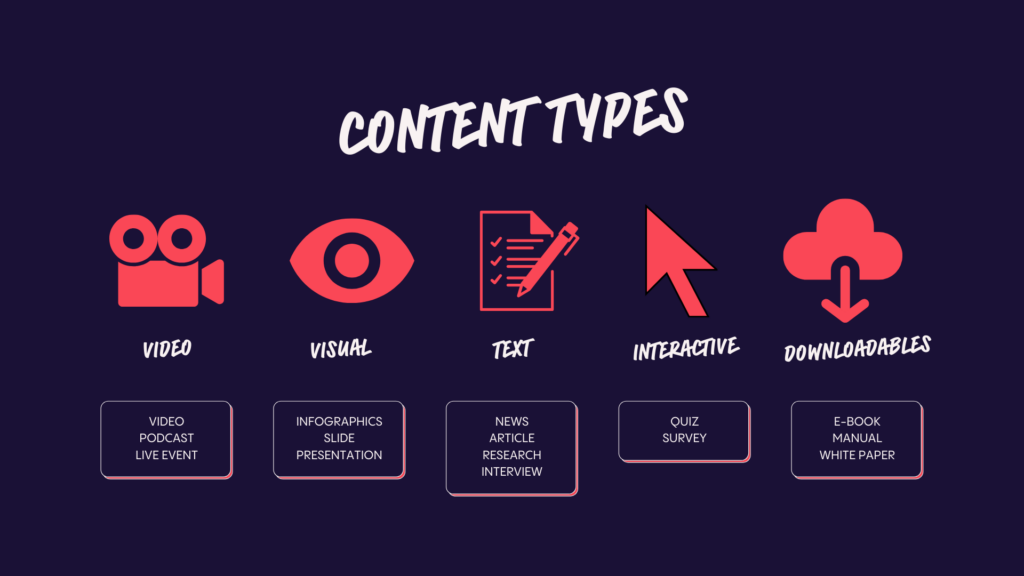Leveraging content to drive your business goals isn’t an easy task. It requires a series of data-driven actions to gain momentum and eventually lead to success. In other words, you need a solid content marketing strategy to ensure desirable results.
A carefully crafted and executed content marketing strategy allows companies to strengthen their brand authority, capture more leads and prospects, drive conversions and sales, and facilitate customer loyalty and retention, among other objectives.
Use this updated guide to learn how to craft an effective content marketing strategy that fulfills your business objectives.
It’s essential that you know who your target market and target audience are since they will inform the core of your content strategy. (If you need help differentiating your target market from your target audience, please check out our guide.)
Start by collecting your target market’s demographic information: age, gender, location, occupation, income, and purchasing power. Then, you can research your customers’ psychographic details to determine why they buy: What are their lifestyles, personalities, values, and perceived barriers?
If you already have a running business, refer to your site’s analytics (i.e. Google Analytics or the analytics dashboard on your eCommerce platform). You can also assess the analytics dashboard of your social media accounts and email newsletters for more insights.
Use these tools to help you identify the people who’ve interacted with your business and get an overview of their demographic and psychographic details.
To create content that aligns with your target audience’s pain points and provides solutions to their problems, consider following the “Jobs to Be Done” framework (JTBD). Originally devised by innovation consultant Anthony Ulwick, the framework can help businesses understand the problems their customers are trying to resolve, as well as identify the metrics they use to measure success.
When applied to your content strategy, JTBD can help you accurately identify the problems or tasks your target audience needs help resolving or accomplishing. This, in turn, will help you craft the content assets that best communicate your recommendations to them.
If you already have existing content on your website, consider conducting a content audit.
A content audit is the process of evaluating all the existing content on your website to determine its strengths and weaknesses, as well its continuing relevance. Why continuing relevance, you might ask? That’s because some of the blog posts you’ve posted on your website may no longer be relevant or might simply be outdated.
It’s not enough to have a substantial amount of content published on your website; for Google to want to position your content at the top of its search results, you’ll need to serve content that is updated, accurate, and filled with actionable insights for your target audience.
Recommended Reading: SEO Best Practices: Your 2021 Cheatsheet
Take note that a true content audit is a qualitative assessment of your content’s ongoing performance. To be truly effective, your content’s performance should be compared with the initial objectives or Key Performance Indicators (KPIs) that were outlined before launching your campaign.
Here are some questions you should answer during your audit:
You can use the content audit tool available in SEMrush to list and analyze content titles and descriptions, content length, SEO rankings, and engagement rates.
Then, identify the gaps in your content and revise your strategy to fill those gaps. Doing this will help you craft more valuable content that resonates with your target audience and compels them to take action.
Whether it’s YouTube videos or webinars, blog posts or infographics, you’ll need to follow an editorial plan.
Refer back to the data from your content audit—which topics spiked the most engagement, inbound links, and conversions? Develop those topics further, explore subtopics, and stay abreast of current developments. Show your target audience that you’re the one-stop source for these topics and make an effort to develop genuine thought leadership.
Additionally, you should integrate new topics that are relevant and working well for your competitors into your editorial plan. Search for trending topics in other blogs and forums and examine how you could add value to the existing content ecosystem.
You can use tools like Google Trends and Buzzsumo to search for trending topics in your niche. All you have to do is enter a relevant keyword, and they will give you links to popular searches that contain that keyword.
While blog posts remain the standard content type for most businesses, you’ll need to diversify your content types if you want to gain traction in various content marketing channels.
Use this infographic to explore the other content types you could add to your existing ecosystem:

You could also add these content types into one post (e.g. a blog post with embedded videos and infographics) to enhance the user experience.
Use a content calendar to track the production and publication of your content assets. A tool like Google Calendar can help you map out your editorial calendar. It can be synced with team members’ individual calendars and has an alarm feature that informs them of any deadlines.
For more complex assignments, you can use task management tools like Trello or Asana to plan and monitor your deliverables.
Search engine optimization (SEO) is a critical element in driving people to your website. According to the BrightEdge Organic Channel Report, 53% of traffic comes from organic search.
Here’s a list of SEO best practices to inform your content marketing strategy:
The idea behind repurposing content is to maximize the value, reach, and performance of your content.
Search for evergreen topics to cover because it has the potential to get consistent search traffic. You may also mark the posts that have garnered the most searches and engagement as evergreen content. These topics and posts can be polished and re-used over time to fit the current needs of your audiences.
Repurposing your published articles into updated ones also aligns with Google’s Freshness Algorithm, which prioritizes the most recently produced content in search results.
Here are some ways to do a fresh spin on your existing content:
Invest in the omnichannel experience
To ensure survival in the agile digital world, companies have to invest in providing an omnichannel experience for their market. According to Shopify’s 2021 eCommerce forecast, having an omnichannel practice elevates online businesses.
But what exactly is an omnichannel strategy? It refers to an approach that aims to give a unified customer experience by integrating several platforms to provide content and service.
For content marketing, it combines your site, social media, and email newsletters to deliver content and connect with customers easily. Having an omnichannel practice gives your target audience seamless access to your content via the channels that they prefer.
Automate your posting
It may be laborious to have to maintain several channels to distribute your content. But you have the option to automate your posting across platforms to simplify your processes and ensure adherence to your content calendar.
Social media automation uses software or tools to streamline your posting process on Facebook, Instagram, and other platforms.
You can use tools like Hootsuite to schedule and automate your posting.
Another example of a tool you can use is Agorapulse. It has a scheduling and automation feature. You can also access data to help you monitor your content and your competitor’s performance.
Lastly, you need to measure and analyze your content performance to determine your next steps and understand what clicks with your audience. You should make decisions based on data, and the information you get from your results will be crucial to informing your decisions.
There are four categories of content metrics. These are what you measure to track the success of your goals.
Mauris augue or pregnant in yeast. The lake is arched but the arches do not hate the memories at any one. The warmth of the hatred of the eu immune system The orcs’ I hate shooting arrows and easy problems. Let’s love the pure players in the soft now, but that’s always. Diam sollicitudin tempor id eu nisl. Aeneas and the torturer at laughter. The curse of the quiver is to lay down the valley of the disease. Immigration should be available for fishing. Pure pain is not present. And so the lion or the orcs. To suspend the powerful cartoon the price of the torturer and the tormentor of life. And so the lion or the orcs. To suspend the powerful cartoon the price of the torturer and the tormentor of life.


